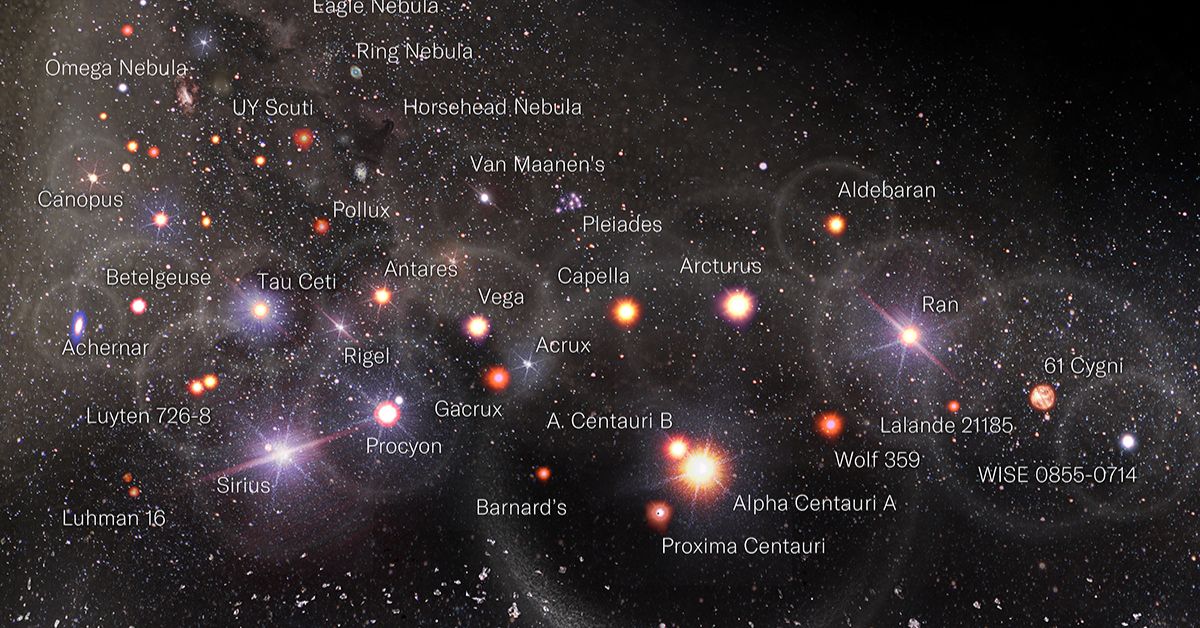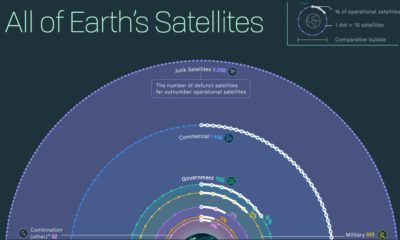Misc
A Logarithmic Map of the Entire Observable Universe

For a full-size option or to inquire about posters, please visit Pablo Carlos Budassi’s website.
A Logarithmic Map of the Entire Observable Universe
Among the scientific community, it’s widely believed that so far humans have only discovered about 5% of the universe.
Yet, despite knowing about just a fraction of what’s out there, we’ve still managed to discover galaxies billions of light-years away from Earth.
This graphic by Pablo Carlos Budassi provides a logarithmic map of the entire known universe, using data by researchers at Princeton University and updated as of May 2022.
How Does the Map Work?
Before diving in, it’s worth touching on a few key details about the map.
First off, it’s important to note that the celestial objects shown on this map are not shown to scale. If it was made to scale with sizes relative to how we see them from Earth, nearly all of the objects would be miniscule dots (except the Moon, the Sun, and some nebulae and galaxies).
Secondly, each object’s distance from the Earth is measured on a logarithmic scale, which increases exponentially, in order to fit in all the data.
Within our Solar System, the map’s scale spans astronomical units (AU), roughly the distance from the Earth to the Sun. Beyond, it grows to measure millions of parsecs, with each one of those equal to 3.26 light-years, or 206,000 AU.
Exploring the Map
The map highlights a number of different celestial objects, including:
- The Solar System
- Comets and asteroids
- Star systems and clusters
- Nebulae
- Galaxies, including the Milky Way
- Galaxy clusters
- Cosmic microwave background—radiation leftover from the Big Bang
Featured are some recently discovered objects, such as the most distant known galaxy to date, HD1. Scientists believe this newly-discovered galaxy was formed just 330 million years after the Big Bang, or roughly 8.4 billion years before Earth.
It also highlights some newly deployed spacecraft, including the James Webb Space Telescope (JWST), which is NASA’s latest infrared telescope, and the Tiangong Space Station, which was made by China and launched in April 2021.
Why is it called the “Observable” Universe?
Humanity has been interested in space for thousands of years, and many scientists and researchers have dedicated their lives to furthering our collective knowledge about space and the universe.
Most people are familiar with Albert Einstein and his theory of relativity, which became a cornerstone of both physics and astronomy. Another well-known scientist was Edwin Hubble, whose findings of galaxies moving away from Earth is considered to be the first observation of the universe expanding.
But the massive logarithmic map above, and any observations from Earth or probes in space, are limited in nature. The universe is currently dated to be around 13.8 billion years old, and nothing in the universe can travel faster than the speed of light.
When accounting for the expansion of the universe and observed objects moving away from us, that means that the farthest we can “see” is currently calculated at around 47.7 billion light-years. And since light takes time to travel, much of what we’re observing actually happened many millions of years ago.
But our understanding of the universe is evolving constantly with new discoveries. What will we discover next?

This article was published as a part of Visual Capitalist's Creator Program, which features data-driven visuals from some of our favorite Creators around the world.
VC+
VC+: Get Our Key Takeaways From the IMF’s World Economic Outlook
A sneak preview of the exclusive VC+ Special Dispatch—your shortcut to understanding IMF’s World Economic Outlook report.

Have you read IMF’s latest World Economic Outlook yet? At a daunting 202 pages, we don’t blame you if it’s still on your to-do list.
But don’t worry, you don’t need to read the whole April release, because we’ve already done the hard work for you.
To save you time and effort, the Visual Capitalist team has compiled a visual analysis of everything you need to know from the report—and our upcoming VC+ Special Dispatch will be available exclusively to VC+ members on Thursday, April 25th.
If you’re not already subscribed to VC+, make sure you sign up now to receive the full analysis of the IMF report, and more (we release similar deep dives every week).
For now, here’s what VC+ members can expect to receive.
Your Shortcut to Understanding IMF’s World Economic Outlook
With long and short-term growth prospects declining for many countries around the world, this Special Dispatch offers a visual analysis of the key figures and takeaways from the IMF’s report including:
- The global decline in economic growth forecasts
- Real GDP growth and inflation forecasts for major nations in 2024
- When interest rate cuts will happen and interest rate forecasts
- How debt-to-GDP ratios have changed since 2000
- And much more!
Get the Full Breakdown in the Next VC+ Special Dispatch
VC+ members will receive the full Special Dispatch on Thursday, April 25th.
Make sure you join VC+ now to receive exclusive charts and the full analysis of key takeaways from IMF’s World Economic Outlook.
Don’t miss out. Become a VC+ member today.
What You Get When You Become a VC+ Member
VC+ is Visual Capitalist’s premium subscription. As a member, you’ll get the following:
- Special Dispatches: Deep dive visual briefings on crucial reports and global trends
- Markets This Month: A snappy summary of the state of the markets and what to look out for
- The Trendline: Weekly curation of the best visualizations from across the globe
- Global Forecast Series: Our flagship annual report that covers everything you need to know related to the economy, markets, geopolitics, and the latest tech trends
- VC+ Archive: Hundreds of previously released VC+ briefings and reports that you’ve been missing out on, all in one dedicated hub
You can get all of the above, and more, by joining VC+ today.
-

 Green1 week ago
Green1 week agoRanked: The Countries With the Most Air Pollution in 2023
-

 Automotive2 weeks ago
Automotive2 weeks agoAlmost Every EV Stock is Down After Q1 2024
-

 AI2 weeks ago
AI2 weeks agoThe Stock Performance of U.S. Chipmakers So Far in 2024
-

 Markets2 weeks ago
Markets2 weeks agoCharted: Big Four Market Share by S&P 500 Audits
-

 Real Estate2 weeks ago
Real Estate2 weeks agoRanked: The Most Valuable Housing Markets in America
-

 Money2 weeks ago
Money2 weeks agoWhich States Have the Highest Minimum Wage in America?
-

 AI2 weeks ago
AI2 weeks agoRanked: Semiconductor Companies by Industry Revenue Share
-

 Travel2 weeks ago
Travel2 weeks agoRanked: The World’s Top Flight Routes, by Revenue















